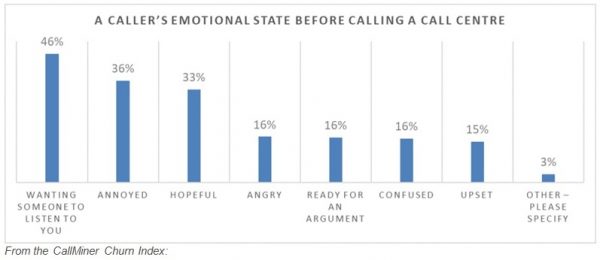Creating Happy Agents by Removing the Sources of Agent Churn
 Most companies have teams focused on keeping customers loyal. That’s because everyone knows customer churn costs a business in multiple ways. But often, the same effort is not given to keeping call centre agents loyal and engaged. Perhaps that’s why call centre agent churn is as high as 26% in the UK. Losing agents at this rate obviously costs in terms of budget as you have invested time and training.
Most companies have teams focused on keeping customers loyal. That’s because everyone knows customer churn costs a business in multiple ways. But often, the same effort is not given to keeping call centre agents loyal and engaged. Perhaps that’s why call centre agent churn is as high as 26% in the UK. Losing agents at this rate obviously costs in terms of budget as you have invested time and training.
But it also has negative impacts on team morale, staff loading and ultimately the customer experience. In fact, agent churn can be a driver of customer churn, creating a very costly negative cycle.
Creating a call centre that is built to keep agents happy, engaged and efficient, is essential to keeping your contact centre profitable. We’ve identified six ways to remove the sources of agent churn and create happier, more engaged and more expert contact centre agents.
1. Help your agents overcome negative customer emotions, so the customer leaves the call happy
The reality is that every call centre agent will have to deal with customers who arrive in a negative frame of mind. The CallMiner Churn Index has shown that over a third of customers (36%) say they arrive annoyed; one in six (16%) arrive angry and the same number arrive confused and ready for an argument!

Obviously, dealing with so many upset customers takes its toll emotionally on the agent. This is compounded by a sense of failure if the agent feels the caller has gone away unhappy. Managing a call in a way that converts an unhappy customer into a happy one is therefore incredibly valuable – to the business and the agent.
Customer Engagement Analytics can identify words, phrases and acoustic qualities that demonstrate when a customer is unhappy. They can also identify the reverse, words and phrases that trigger a positive reaction or an approach that delivers a positive outcome. Providing this information to agents increases the likelihood that they can manage a call in a way that satisfies the caller. Real-time analytics goes one step further. It identifies when a call is deteriorating and prompts the agent to adjust what they say, and how they say it, in time to rescue the call.
Supporting your agents with this live call support will make agents feel supported in dealing with difficult and angry customers, but customer experience will improve. The positive impact on emotional and mental wellbeing of sending a customer away happy will be significant for your agents. It will also create a sense of pride in their role as they become increasingly aware of the beneficial impact they have on customers.
 2. Remove any sense of unfair treatment
2. Remove any sense of unfair treatment
While agents may handle dozens of calls a day, their performance is often rated based on supervisors listening to a random selection of their calls. This is often between only 1% and 3% of calls carried out. The fact that more than 95% of calls are not heard, inevitably leads to a belief that any score is not representative of their performance. Having an analytics tool that automatically analyses 100% of their interactions will help in a number of ways. These include:
– Removing any sense of unfairness that comes from being rated based on a random selection. Research by neuroscientists shows that Fairness is one of five key psychological needs that must be met for positive engagement by employees. It also shows that feeling unfairly treated has a damaging effect on decision-making and communication – both essential to an agent’s role
– Using the analysis to enable agents to take control of their own improvement by identifying where they need to improve their performance to deliver a better customer experience. This level of ‘Autonomy’ is another of the five key psychological needs mentioned above. It refers to the brain’s craving to feel that we have choices about what to do and not to do and that we have at least some level of control over our environment and circumstances
– Providing an agent’s supervisor with the data needed to provide very targeted and personalised coaching. This personal coaching is welcomed by the agent because it not only shows that the company is committed to helping them to improve but also shows that coaching is based on a clear need
 3. Help them to continuously learn and develop
3. Help them to continuously learn and develop
It’s very important that agents feel their employer supports their learning and development to keep them happy and motivated. By analyzing 100% of customer interactions, you will take the guesswork out of identifying exactly where agents need help. This enables you to deliver tailored coaching rather than following generic training plans that may not be giving them the guidance they need. Supervisors can use the insight from analyzing 100 percent of their agent’s interactions with customers, to create targeted training programs and ensure agents receive additional coaching to support an agent’s personal improvement objectives.
By giving every agent access to automated, daily scorecards, you can deliver fast and effective performance feedback. This gives supervisors the opportunity to coach agents efficiently. Perhaps more importantly, access to personal performance data (based on every interaction) also helps to create a culture of self-evaluation and improvement, as agents recognise where, on the optimum customer path, they could be improving their performance. For example, if the scorecard shows a need to improve empathy, the agent can focus on this during the next shift. Supervisors can also reinforce the desire to self-coach by using the daily scorecard to recognise the improvements the agent made on their previous shift.
 4. Help them deal with vulnerable customers
4. Help them deal with vulnerable customers
Many call centre agents are likely to encounter vulnerable customers who need special consideration when interacting with them. Customer engagement analytics can identify words, phrases and acoustic qualities that demonstrate vulnerability.
It can also identify when certain words and phrases increase stress levels with the customer or agent (or both). This means it’s possible to identify the emotions of the customer and the agent on the call, good and bad. It’s also possible to understand customer preferences and identify which types of customers react best to different types of solutions. And, most importantly, it means agents can be guided through their calls with prompts and alerts, so they feel supported to follow the best course of action at all times. Handling vulnerable customers in a sensitive and empathetic way can be very rewarding for the agent. Doing so in a manner that is certain to be compliant with legislation or regulatory guidance, can also take the stress out of the call and reduce significantly after call work.
5. Give agents the tools to be an expert and problem solver
Agents want to feel good about the service they provide to customers. The CallMiner Churn Index has shown that two-thirds of customers contact with a problem that needs resolving. So, agents need to know that they will be given the information they need to solve problems on the first call. First Call Resolution data often doesn’t get captured or gets captured incorrectly because, traditionally, it is a difficult metric to track.
One solution is to use engagement analytics to analyse every single interaction. By capturing the actual conversational content and integrating it with caller identifiers, companies can quickly and easily identify repeat contacts. In addition, speech analytics allows the correlation of repeat calls with specific reasons, products, or agents. By identifying the causes of repeat contact, action can then be taken to resolve these issues. By analysing every call, you will also be able to identify the most common existing reasons for problem calls. Agents can then be provided with the information they need to resolve the problems – and send the caller away happy. This will reinforce their Status (another of the five psychological needs) as an expert problem solver – and therefore their sense of achievement.
Agents also need to know if they will have access to the right people to help them when they need it. Connecting frontline agents to back-office experts, who have the specialist information to handle complex problems, can make agents feel supported and also provide the satisfaction of delivering great customer experience. Using technology that alerts team leaders when an agent may need extra assistance, is key to making agents feel supported in their role.
6. Prepare agents to handle new issues as they arise
Agents can expect to be given the information to handle issues that occur frequently. But what about new issues? Will they catch the agent unprepared – leading to a sense of failure? Consumers increasingly use different channels for sending different kinds of messages. By analysing every interaction across multiple channels, engagement analytics can identify potential issues before they have reached the call centre. For example, if there is a problem with a product, and customers are beginning to tweet about it, engagement analytics will be able to identify the emerging trend – giving time for agents to prepare to handle the calls when they arrive
As the volume of data increases, artificial intelligence-fueled analytics will help agents further by predicting issues before they become a serious problem. It will do this by identifying when a course of action creates a particular customer reaction. This will enable you to predict the possible rise in call volumes to your customer centre and also prepare your agents with the right information beforehand to help ensure that they are prepared to handle difficult issues.
If you have an integrated approach to removing the sources of agent churn, you can be certain you will deliver a much better customer experience – and with it a much better financial performance of our call centre.
Additional Information
To download the ‘CallMiner Churn Index’ report Click Here
CallMiner empowers organisations of any size to extract and take action on intelligence from customer interactions for improving customer experience, sales, marketing, and compliance, as well as contact centre agent and customer engagement centre performance. Highlighted by multiple customer achievement awards, including eight Speech Technology implementation awards in the past six years, CallMiner was recently named a leader in the industry analyst report Forrester New Wave: AI-Fueled Speech Analytics Solutions, Q2 2018.
For additional information on CallMiner visit their Website or view their Company Profile
 2. Remove any sense of unfair treatment
2. Remove any sense of unfair treatment 3. Help them to continuously learn and develop
3. Help them to continuously learn and develop 4. Help them deal with vulnerable customers
4. Help them deal with vulnerable customers






